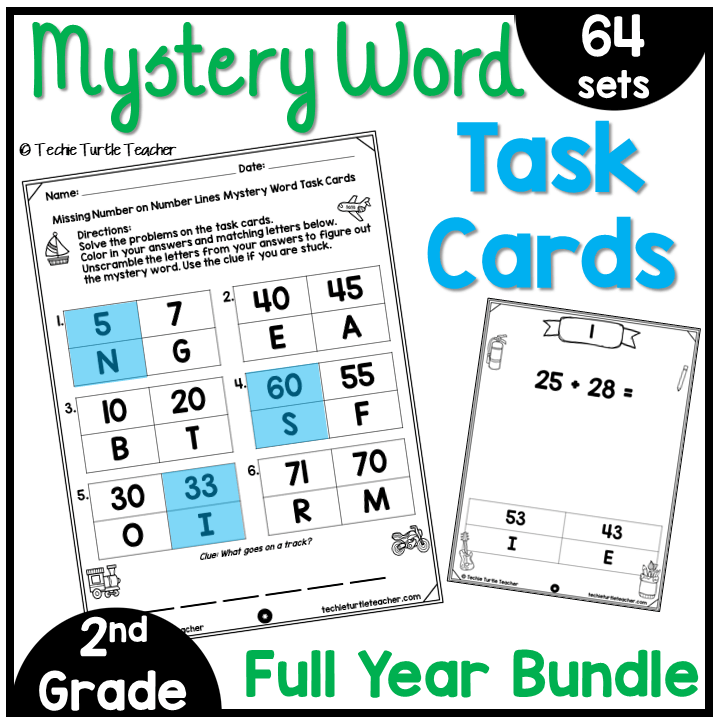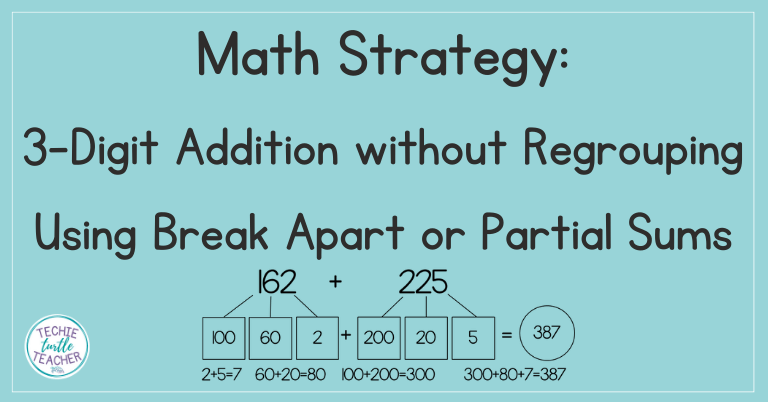Mystery Word Task Cards
Task cards are a great way to get your students up and moving while practicing skills. But your students might get bored using basic task cards all the time.
What if there is a way to add a fun twist to using task cards?
That’s where my Mystery Word Task Cards come into play!
Students will still solve problems on the task cards, but they will collect letters as they go. Once they solve all the problems, they will unscramble the letters they collected to make the mystery word.
There are differentiated levels for each standard. You can pick from the easy, medium, or hard mystery words or use all three levels with your students!
Easy – 6 letter words
Medium – 8 letter words
Hard – 10 letter words
Keep reading to find out how to get a free copy to try in your classroom!
How to Use Mystery Word Task Cards
- Print the task cards and place around the classroom.
- Give the students their answer sheets and clarify any questions they have.
- Students will walk around to the different task cards and solve the problems. You might have your students take a whiteboard or piece of paper to use to show their thinking.
- Once students have solved the problems, they will color in the letter corresponding to their answer for each question.
- After the students have solved all the problems, they will unscramble the letters to find the mystery word.
Why Should Teachers Use These Task Cards?
- Perfect for reviewing topics.
- Differentiated to meet the needs of your learners.
- You will know students have the correct answers if they can identify the mystery word.
- The task cards are perfect to put around the room and have your students walk around to solve problems. It gets them up moving around!
- These cards would work well for Scoot.
- The full-sized version gives you an easy way to review each problem at the end of class.
Try Mystery Word Task Cards in Your Classroom
Click the image below to get your free copy of these Mystery Word Task Cards.
By incorporating the Mystery Word Task Cards into your math curriculum, you can provide an exciting and interactive way for your students to reinforce their mathematical skills and develop critical thinking abilities. These task cards offer a hands-on approach to math learning, promoting conceptual understanding, problem-solving, and mathematical reasoning in 2nd grade students.
Standards Included
- 2.NBT.1: Understand that the three digits of a three-digit number represent amounts of hundreds, tens, and ones; e.g., 706 equals 7 hundreds, 0 tens, and 6 ones.
- 2.NBT.3: Read and write numbers to 1000 using base-ten numerals, number names, and expanded form.
- 2.NBT.4: Compare two three-digit numbers based on meanings of the hundreds, tens, and ones digits, using >, =, and < symbols to record the results of comparisons.
- 2.MD.6: Represent whole numbers as lengths from 0 on a number line diagram with equally spaced points corresponding to the numbers 0, 1, 2,…, and represent whole-number sums and differences within 100 on a number line diagram.
- 2.NBT.2: Count within 1000; skip-count by 5s, 10s, and 100s.
- 2.OA.3: Determine whether a group of objects (up to 20) has an odd or even number of members, e.g., by pairing objects or counting them by 2s; write an equation to express an even number as a sum of two equal addends.
- 2.NBT.5: Fluently add and subtract within 100 using strategies based on place value, properties of operations, and/or the relationship between addition and subtraction.
- 2.OA.1: Use addition and subtraction within 100 to solve one- and two-step word problems involving situations of adding to, taking from, putting together, taking apart, and comparing, with unknowns in all positions, e.g., by using drawings and equations with a symbol for the unknown number to represent the problem.
- 2.NBT.8: Mentally add 10 or 100 to a given number 100–900, and mentally subtract 10 or 100 from a given number 100–900.
- 2.MD.8: Solve word problems involving dollar bills, quarters, dimes, nickels, and pennies, using $ and ¢ symbols appropriately.
- 2.MD.1: Measure the length of an object by selecting and using appropriate tools such as rulers, yardsticks, meter sticks, and measuring tapes.
- 2.MD.5: Use addition and subtraction within 100 to solve word problems involving lengths that are given in the same units, e.g., by using drawings (such as drawings of rulers) and equations with a symbol for the unknown number to represent the problem.
- 2.NBT.7: Add and subtract within 1000, using concrete models or drawings and strategies based on place value, properties of operations, and/or the relationship between addition and subtraction; relate the strategy to a written method. Understand that in adding or subtracting three-digit numbers, one adds or subtracts hundreds and hundreds, tens and tens, ones and ones; and sometimes it is necessary to compose or decompose tens or hundreds.
- 2.MD.7: Tell and write time from analog and digital clocks to the nearest five minutes, using a.m. and p.m.
- 2.G.1: Recognize and draw shapes having specified attributes, such as a given number of angles or a given number of equal faces. Identify triangles, quadrilaterals, pentagons, hexagons, and cubes.
- 2.G.3: Partition circles and rectangles into two, three, or four equal shares, describe the shares using the words halves, thirds, half of, a third of, etc., and describe the whole as two halves, three thirds, four fourths. Recognize that equal shares of identical wholes need not have the same shape.
- 2.OA.4: Use addition to find the total number of objects arranged in rectangular arrays with up to 5 rows and up to 5 columns; write an equation to express the total as a sum of equal addends.














